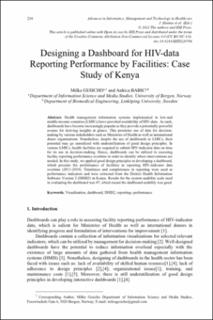| dc.contributor.author | Gesicho, Milka Bochere | |
| dc.contributor.author | Babic, Ankica | |
| dc.date.accessioned | 2022-07-05T12:19:02Z | |
| dc.date.available | 2022-07-05T12:19:02Z | |
| dc.date.created | 2022-07-02T11:51:55Z | |
| dc.date.issued | 2022 | |
| dc.identifier.issn | 0926-9630 | |
| dc.identifier.uri | https://hdl.handle.net/11250/3002762 | |
| dc.description.abstract | Health management information systems implemented in low-and middle-income countries (LMICs) have provided availability of HIV-data. As such, dashboards have become increasingly popular as they provide a potentially powerful avenue for deriving insights at glance. This promotes use of data for decision-making by various stakeholders such as Ministries of Health as well as international donor organizations. Nonetheless, despite the use of dashboards in LMICs, their potential may go unrealized with underutilization of good design principles. In various LMICs, health facilities are required to submit HIV-indicator data on time for its use in decision-making. Hence, dashboards can be utilized in assessing facility reporting performance overtime in order to identify where interventions are needed. In this study, we applied good design principles in developing a dashboard, which presents the performance of facilities in reporting HIV-indicator data overtime (2011–2018). Timeliness and completeness in reporting were used as performance indicators and were extracted from the District Health Information Software Version 2 (DHIS2) in Kenya. Results for the system usability scale used in evaluating the dashboard was 87, which meant the dashboard usability was good. | en_US |
| dc.language.iso | eng | en_US |
| dc.publisher | IOS Press | en_US |
| dc.rights | Navngivelse-Ikkekommersiell 4.0 Internasjonal | * |
| dc.rights.uri | http://creativecommons.org/licenses/by-nc/4.0/deed.no | * |
| dc.title | Designing a Dashboard for HIV-data Reporting Performance by Facilities: Case Study of Kenya | en_US |
| dc.type | Journal article | en_US |
| dc.type | Peer reviewed | en_US |
| dc.description.version | publishedVersion | en_US |
| dc.rights.holder | Copyright 2022 The authors and IOS Press | en_US |
| cristin.ispublished | true | |
| cristin.fulltext | original | |
| cristin.qualitycode | 1 | |
| dc.identifier.doi | 10.3233/SHTI220706 | |
| dc.identifier.cristin | 2036830 | |
| dc.source.journal | Studies in Health Technology and Informatics | en_US |
| dc.source.pagenumber | 238-241 | en_US |
| dc.identifier.citation | Studies in Health Technology and Informatics. 2022, 238-241. | en_US |

